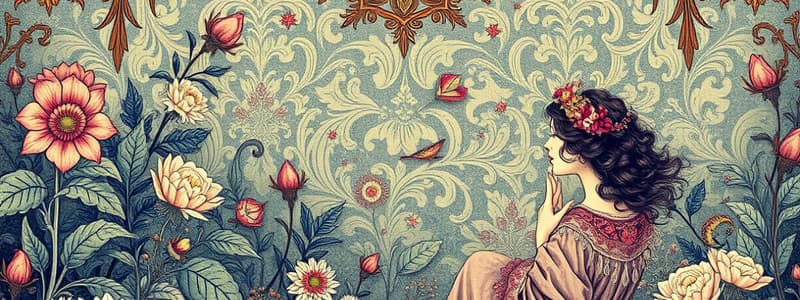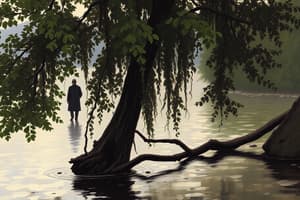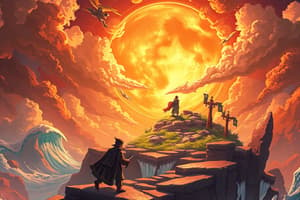Podcast
Questions and Answers
What is the definition of line?
What is the definition of line?
- a flat 2D element
- an element that encloses volume
- a point moving in space (correct)
- the lightness or darkness of tones
What is a shape?
What is a shape?
an element that is 2D, flat, or limited to height and width
What is the definition of form?
What is the definition of form?
3D and encloses volume; includes height, width, and depth
What does value refer to?
What does value refer to?
What is color composed of?
What is color composed of?
What does space refer to in art?
What does space refer to in art?
What is texture in art?
What is texture in art?
What does contrast refer to?
What does contrast refer to?
What is positive space?
What is positive space?
What is negative space?
What is negative space?
What is blind contour drawing?
What is blind contour drawing?
What is composition in art?
What is composition in art?
What is a vanishing point?
What is a vanishing point?
What is medium in art?
What is medium in art?
What are four shading techniques?
What are four shading techniques?
What is monochromatic color scheme?
What is monochromatic color scheme?
What is actual texture?
What is actual texture?
What is simulated texture?
What is simulated texture?
What is linear perspective?
What is linear perspective?
What is overlapping?
What is overlapping?
What is aerial perspective?
What is aerial perspective?
What is high/low placement?
What is high/low placement?
What are organic shapes?
What are organic shapes?
What are geometric shapes?
What are geometric shapes?
What is shading?
What is shading?
What are primary colors?
What are primary colors?
What are secondary colors?
What are secondary colors?
What is background in art?
What is background in art?
What is implied texture?
What is implied texture?
What is hue?
What is hue?
What is a color wheel?
What is a color wheel?
What is middle ground in art?
What is middle ground in art?
What is hatching?
What is hatching?
What is crosshatching?
What is crosshatching?
What is stippling?
What is stippling?
What is a vanishing point?
What is a vanishing point?
Flashcards are hidden until you start studying
Study Notes
Elements of Art
- Line: A point that moves in space, forming the basic structure for other forms.
- Shape: A two-dimensional element defined by height and width, often perceived flat on a surface.
- Form: A three-dimensional element that encompasses volume, consisting of height, width, and depth.
- Value: Refers to the lightness or darkness of a color, essential in creating depth and contrast in artwork.
- Color: Composed of three properties: hue (the color itself), value (lightness/darkness), and intensity (brightness/dullness).
Spatial Elements
- Space: Refers to the area or emptiness surrounding and between objects, crucial for perspective and composition.
- Positive Space: The main focus area in an artwork where subjects are placed.
- Negative Space: The background area that complements the positive space.
Texture
- Texture: The representation or illusion of how something feels, categorized as:
- Actual Texture: Tangible surfaces that feel as they appear.
- Simulated Texture: Visual texture that appears similar to a physical texture but is not.
- Implied Texture: Created textures that suggest how an object might feel based on visual cues.
Techniques and Composition
- Blind Contour Drawing: An exercise focusing on drawing without looking at the paper, enhancing observation skills.
- Composition: The arrangement of elements in a piece of art following principles to create a balanced whole.
- Overlapping: Technique where objects are placed atop each other to create a sense of depth.
- Aerial Perspective: Method that depicts distant objects as lighter and less detailed, adding depth to artwork.
- High/Low Placement: Visual cues based on object placement; lower objects appear closer, while higher objects seem farther away.
Perspective
- Linear Perspective: Technique that mimics how human vision perceives depth by converging parallel lines into a vanishing point.
- Vanishing Point: A point where parallel lines appear to meet, contributing to a sense of three-dimensionality.
Shapes and Colors
- Organic Shapes: Irregular, freeform shapes that often resemble forms found in nature.
- Geometric Shapes: Precise shapes defined mathematically, such as circles and squares.
- Primary Colors: Red, yellow, and blue - the foundation of all other colors.
- Secondary Colors: Created by mixing primary colors, resulting in green, orange, and purple.
- Color Wheel: Visual representation of primary, secondary, and tertiary colors illustrating their relationships.
Shading Techniques
- Shading: Techniques that create varying levels of darkness; includes:
- Hatching: Consists of parallel lines running in one direction.
- Crosshatching: Involves crisscrossing lines for deeper shading.
- Stippling: Utilizes dots to create shading effects.
Additional Concepts
- Value and Color Relationships: The interplay of lightness, darkness, and hue contributes significantly to the mood and depth of a work.
- Middle Ground: The area between foreground (closest elements) and background in a piece of artwork.
Studying That Suits You
Use AI to generate personalized quizzes and flashcards to suit your learning preferences.




